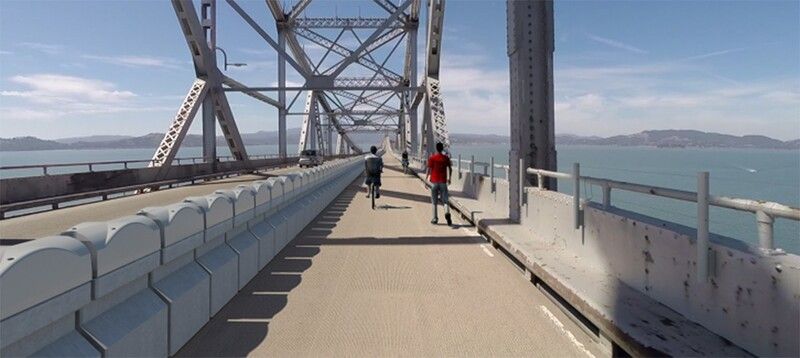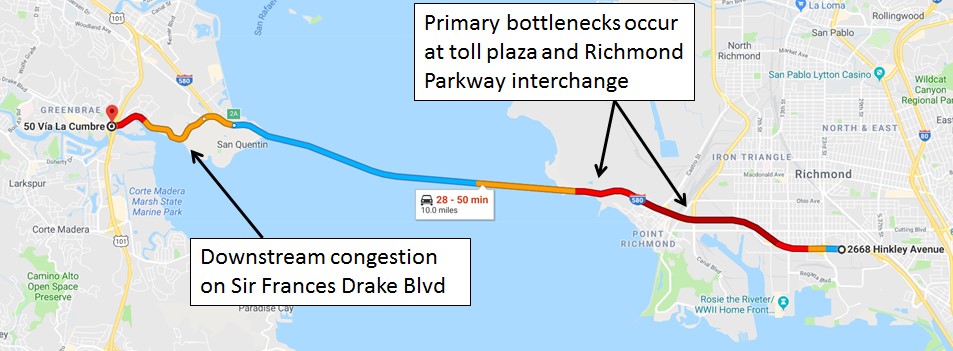 The Transportation Authority of Marin (TAM) is making a strong push to add a third westbound lane on the Richmond-San Rafael Bridge to alleviate congestion during the morning rush hour. In April, the addition of a third eastbound lane was credited with reducing evening commute times by 20 minutes and helping to reduce spillover backups onto US-101. Marin County’s leaders suggest that a third westbound lane could have a similar effect and should be implemented in lieu of a proposed Bay Trail connection. However, a closer examination of traffic patterns suggests that Marinites are misinterpreting westbound traffic patterns.
The Transportation Authority of Marin (TAM) is making a strong push to add a third westbound lane on the Richmond-San Rafael Bridge to alleviate congestion during the morning rush hour. In April, the addition of a third eastbound lane was credited with reducing evening commute times by 20 minutes and helping to reduce spillover backups onto US-101. Marin County’s leaders suggest that a third westbound lane could have a similar effect and should be implemented in lieu of a proposed Bay Trail connection. However, a closer examination of traffic patterns suggests that Marinites are misinterpreting westbound traffic patterns.
A third westbound lane would not address any of the three major bottlenecks facing Richmond-San Rafael Bridge commuters:
- The first bottleneck occurs as commuters merge onto I-580 from Richmond Parkway.
- The second bottleneck occurs at the toll plaza
- The third bottleneck occurs in Marin for drivers traveling along Sir Francis Drake Boulevard, particularly around the US-101 interchange.
Whereas upstream and downstream bottlenecks account for 20-30 minutes of delay, the bridge itself flows relatively well. While drivers do experience moderate speeds on the first part of the bridge, a third lane could amount to about a minute or two of savings at best. In contrast, the third eastbound lane was specifically designed to alleviate the eastbound bottleneck by resolving the merging conflict between I-580 and Sir Francis Drake Boulevard, resulting in much greater time savings.
Housing Problem in Marin County
If a third westbound lane wouldn’t help alleviate traffic congestion, then why are Marin County leaders making such a big deal about it? There is clearly an element of political grandstanding and a poor understanding of commute patterns. But it’s strange that county leaders are suddenly concerned by the plight of nonresidents commuting from the East Bay. As it turns out, TAM’s reasoning is rooted in anxiety over maintaining the county’s exclusivity and obstructing new housing production for its growing workforce:
“The record low unemployment in Marin County has Marin County employers stating that problems hiring and retaining employees is of great concern. The need to address the commute of employees coming from the East Bay is growing daily. Many of our teachers, safety workers such as police and fire, and other workers depend on the Bridge daily to get to work on time.”
TAM is essentially acknowledging that Marin depends on importing labor from the East Bay because the county has not built enough housing to support itself. Speeding up the Richmond-San Rafael Bridge enables the county to continue maintaining the status quo. From that lens, TAM’s advocacy is self-serving and at odds with regional and state goals for more housing near jobs and reducing vehicle miles traveled.
TAM’s position on a third westbound lane is neither technically sound nor smart policy; it’s bogus planning borne out of self-interest. While few are disputing that a bike trail will yield substantial ridership (in part due to poor connections on the Marin County side), picking a fight to replace the trail with another project of limited utility is a poor use of limited agency resources. Perhaps TAM leaders should instead spend more time worrying about how to house the county’s teachers, police officers, and firefighters within Marin so they could have shorter commutes.




 AI-search
AI-search  Email
Email